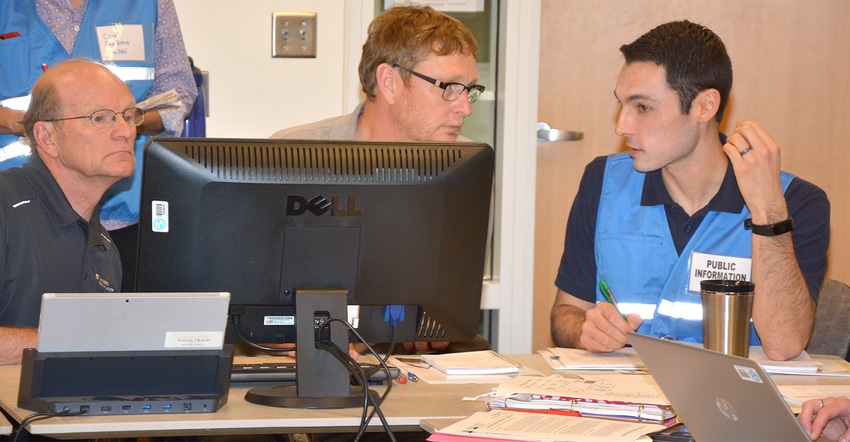May 29, 2018

With its involvement of 100-plus people from Minnesota agencies and livestock organizations, to call a three-day response to a mock outbreak of foot-and-mouth disease simply an exercise only skims the surface of what transpired.
In early May, Minnesota and several other states participated in USDA’s first large-scale animal disease response exercise. The effort required participants to collaborate across agencies and with farm groups as they worked to release news of the alleged outbreak, and to provide proper follow-up.
In Minnesota, the Board of Animal Health, the Minnesota Department of Agriculture, additional state agencies, the University of Minnesota and several livestock industry organizations participated, as did I —as an observer and a member of the media during a mock press conference.
To enhance realism, USDA used an online disaster preparedness training platform called SimulationDeck, which provided real-time information and social media posts.
On Day 1 of the “outbreak,” USDA issued an alert that the disease was found in Montana. It was early on Day 2 that the disease was “found” on a Douglas County, Minn., dairy and hog farm. And by Day 3, the mock outbreak spread to several other states.
When I arrived at the MBAH office in St. Paul, Minn., early on Day 2, everyone was already engaged in the task at hand. People with laptops were stationed at tables organized by area of responsibility or specialty, such as planning, logistics, operations, safety, technical skills, public information and livestock liaisons. Large charts on a wall mapped out the chain of command. Each table had its own landline telephone.
For some of these folks, the exercise reinforced what they learned about response efforts when the state livestock and poultry industries experienced bovine tuberculosis and avian influenza.
Here is a slice of how the second day’s exercise unfolded:
3 a.m. The University of Minnesota Vet Diagnostic Lab confirmed FMD on a Douglas County farm.
8:40 a.m. A national briefing call with USDA provided updates on the status of FMD in Montana and Minnesota. The positive Montana herds were placed under quarantine. Officials there also were dealing with confusion about cattle and sheep origin, and animal movement in and out of state. Plus, a judge issued an injunction preventing herd disposal, on grounds of cruelty. Depopulation would not occur until that legal issue was resolved. Minnesota was given a 72-hour “standstill” order, meaning no livestock movement was allowed.
9:15 a.m. USDA announced presumptive positive FMD animals in South Dakota and Colorado.
9:22 a.m. Planning and logistics teams, deep in discussion, laid out options and issues connected with depopulating the infected farm: use of captive bolt; disposing of carcasses by composting, burial or cremation; animal and human safety during depopulation; the farm layout; and the on-farm equipment available for animal handling.
9:30 a.m. MBAH and MDA public information staff held a conference via phone with USDA. Talking points for the public were discussed. USDA’s Animal and Plant Health Inspection Service planned to issue its first press release, with a national press conference at 1 p.m. A MBAH/MDA press conference was planned for 2 p.m. An added bonus: SimulationDeck “bleated” (an appropriate spinoff on “tweeted”) that an anti-livestock group planned a 1 p.m. “no animal deaths” rally.
10:35 a.m. Livestock stakeholders discussed issues of concern, such as milk pickup in Douglas County, trade implications and human health questions. They were getting calls about livestock markets shutting down because animal movement was prohibited. They could not answer questions from callers regarding closed markets. They also prepared for the Minnesota press conference.
11:40 a.m. The operations team chief announced, “Our goal today is getting the infected farm depopulated.” Leaders in disease management, disease support and disease surveillance gave reports. A map showing the 10-km control zone was posted on the wall.
12:45 p.m. MBAH moderated a conference call for livestock stakeholders in-house and outstate. Everyone was updated on events, and stakeholders were asked to look for animals exhibiting clinical signs of FMD. All farmers in the control zone had been notified by this time about FMD. Questions surfaced from the field: Can feed trucks still make deliveries? Can milk still be picked up? Any restrictions on embryos and semen? MBAH promised daily updates. Someone requested text message alerts for updates.
1 p.m. Operations and incident teams reviewed what was done and what needed to be done by the day’s end. USDA employees arriving in the state introduced themselves.
1:10 p.m. From its Washington, D.C., office, USDA held its first press conference, announcing FMD had been found in Minnesota and five other states.
2 p.m. Minnesota held its first press conference on FMD at the MBAH.
A for effort
Several things impressed me throughout the day. First, the depth and breadth of planning that took place prior to the mock exercise. There truly was a sense of realism in the rooms as participants offered comments and ideas on how to respond, and completed assigned tasks. When biosecurity was discussed, for example, every avenue was covered — from wearing booties to which vehicles should or should not drive past the farmhouse on an infected farm.
As in real life, participants spent part of their time waiting. They did not know the timing or nature of what might happen next, except when in-house meetings were announced.
The social media component on the disaster preparedness training platform kept participants continually engaged. Some posts, as in real life, were fear-mongering. Others, wacky.
Overall, from my vantage point, those who practiced how they would respond to an animal disease outbreak were at the top of their game. Throughout the exercise, several evaluators graded how they performed. While there is always room for improvement, I am sure the Minnesota contingent scored high. Thanks to all involved for fine-tuning efforts at animal disease response.
You May Also Like




